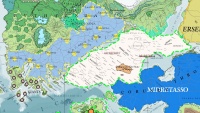Difference between revisions of "Moigthe"
Trismegistus (talk | contribs) m |
Trismegistus (talk | contribs) m |
||
| Line 7: | Line 7: | ||
=Moigthe Language= | =Moigthe Language= | ||
{{Main|Moigthe Language}} | {{Main|Moigthe Language}} | ||
| + | |||
| + | =Beliefs= | ||
| + | Caves and Caverns were seen by the ancient Moigthe as places where one could leave the world of the living and enter the world of the dead. Less frequently, they are seen as portals to other worlds, in addition to the world of the dead. | ||
=See Also= | =See Also= | ||
Revision as of 12:31, 13 January 2017
A Gwenyan people derived from the ancient Erserceans and thus of the Donavish branch of Gwenyan languages. The tribes of the transitional period between the Erserceans and the Moigthe are called the Proto-Moigthe. The Moigthe are a broad ethnic group of humans of Gwenyan descent and are the principal forebears of the Ambrulians, High Pytharnians, the Durandwórese, the Asbardians, the Myernians, the Goldenlings, and the Erechórebese, including the ancient Yophenths. The Medibgóëse, Gonfalese, and Kasthavians must count the ancient Moigthe as their ancestors as well.
Moigthe Tribes
Around the time of Salmakhamer, the Moigthe tribes were spread across southern coast of Pytharnia. Known major tribes were the Luabh-Corra, Agairha, Trebhirru, Glammoigtha, Hundorna, Nualta, Tantha, Cascara, Amenirra, Thiagona, Scaliartha, Rhevorna, Brunada, Umatha, and Smiaha.
Moigthe Language
Beliefs
Caves and Caverns were seen by the ancient Moigthe as places where one could leave the world of the living and enter the world of the dead. Less frequently, they are seen as portals to other worlds, in addition to the world of the dead.
See Also
| This article is a stub. It requires further development by the creator. |
